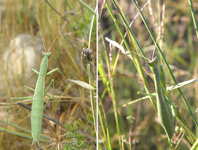Abstract
Chopard (1916) published a brief paper in which he cited and described a number of praying mantis species from the neotropics. The specimens he studied belonged to the prominent Spanish Entomologist Ignacio Bolívar y Urrutia (1850–1944), whose collection is now housed at the Museo Nacional de Ciencias Naturales in Madrid (MNCN), Spain (Izquierdo et al. 1997). In this publication Chopard described Thespoides bolivari Chopard, 1916 as a new genus and species, based on a single male obtained by French coleopterist René Oberthür in Cauca, Colombia. According to Chopard (1916) the specimen was remarkable for having, among other features, an abdomen that is markedly shorter than the rest of its body—certainly an unusual morphological trait among the Mantodea. Chopard assigned Thespoides to the Miopteryginae (Thespidae), but it was later reassigned (together with Angela Serville, 1839 as the “Angelae group”) to the subfamily Schizocephalinae (Mantidae) by Giglio-Tos (1927). Current classifications consider the Angelinae to comprise a distinct subfamily of the Mantidae, with Thespoides and Angela as the only representatives of this subfamily with a Neotropical distribution (e.g. Ehrmann 2002).

